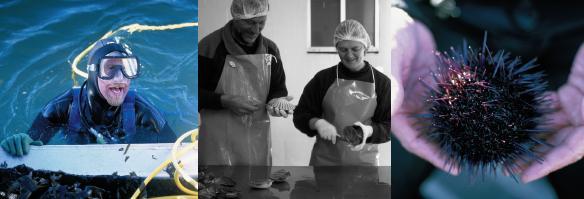
FROM SEA FLOOR TO restaurant door
Tasmanian waters are subject to quota restrictions to ensure the ongoing proliferation of all species of commercially coveted seafood. And at 23 metres in depth at its deepest point, Georges Bay is teeming with sea life.
Dale Ridgers, a contract diver, is usually in the water by 9 a.m. and completes two dives in his working day, finishing his last dive and delivering to the Salty Seas factory not long after 1 p.m. Ridgers and the other divers who supply Salty Seas unload their dinghies at the front door of the factory, which sits on the edge of Media Cove, on the Golden Fleece Rivulet that feeds into the heart of Georges Bay.
Between dives, Dale Ridgers stashes his haul in the open water at what is known as a ‘depuration site’, a series of suspended nets to cleanse the shellfish of impurities, sand and grit while allowing them to remain in robust health, enjoying the the pristine tidal waters of Georges Bay. As required and when each species has gone through its prescribed depuration period, Dale removes them from the water and transports them to the Salty Seas factory.
The only problem with this system is the poacher. ‘Yes, I’ve had the odd catch go missing,’ he chuckles, ‘but on the whole it hasn’t been too much of a problem’. He points out that poachers really only operate on a small, domestic scale and only ever when the water and outside temperature make being in the sea an attractive option. ‘It gets pretty cold down here, you know.’
A truck arrives daily at 5 p.m., and all produce must be ready for this transport to make the flights out of Launceston (several hours’ drive on the winding roads from St Helens). Following the collection, a couple of hours are spent returning the factory to its sterilised conditions before Paulsen, Weekes and their staff review upcoming orders for the following day and clock off at about 7 p.m. ‘You have to like it,’ Weekes reflects on his labour-intensive occupation.
